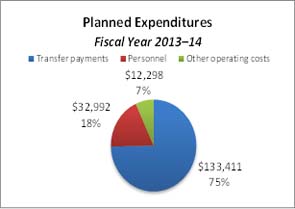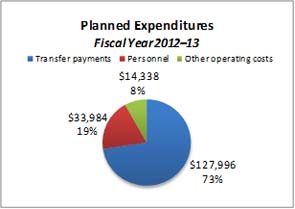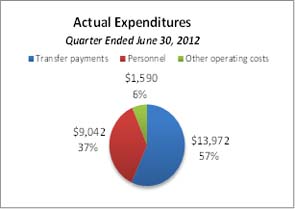Western Economic Diversification Canada’s Quarterly Financial Report for the quarter ended June 30, 2013
Statement outlining results, risks and significant changes in operations, personnel and program
- Introduction
- Highlights of fiscal quarter and fiscal year to date (YTD) results
- Risks and Uncertainties
- Significant changes in relation to operations, personnel and programs
- Budget 2012 Implementation
- Quarterly Financial Report
Introduction
This quarterly financial report should be read in conjunction with the Main Estimates and Canada's Economic Action Plan 2012 (Budget 2012). It has been prepared by management as required by section 65.1 of the Financial Administration Act and in the form and manner prescribed by the Treasury Board. This quarterly report has not been subject to an external audit or review.
Authority, Mandate and Program Activities
Western Economic Diversification Canada (WD) is mandated to "promote the development and diversification of the economy of Western Canada and to advance the interests of the West in national economic policy, program and project development and implementation.
"
The Report on Plans and Priorities and Main Estimates provide further information on WD's authority, mandate and program activities.
Basis of Presentation
This quarterly report has been prepared by management using an expenditure basis of accounting. The accompanying Statement of Authorities includes the department's spending authorities granted by Parliament and those used by the department, consistent with the Main Estimates for fiscal year 2013–14. This quarterly report has been prepared using a special purpose financial reporting framework designed to meet financial information needs with respect to the use of spending authorities.
The authority of Parliament is required before moneys can be spent by the Government. Approvals are given in the form of annually approved limits through appropriation acts or through legislation in the form of statutory spending authority for specific purposes.
The department uses the full accrual method of accounting to prepare and present its annual departmental financial statements that are part of the departmental performance reporting process. However, the spending authorities voted by Parliament remain on an expenditure basis.
As part of the Parliamentary business of supply, the Main Estimates must be tabled in Parliament on or before March 1 preceding the new fiscal year. Budget 2012 was tabled in Parliament on March 29, after the tabling of the Main Estimates on February 28, 2012. As a result, the measures announced in the Budget 2012 could not be reflected in the 2012–13 Main Estimates.
In fiscal year 2012–13, frozen allotments were established by Treasury Board authority in departmental votes to prohibit the spending of funds already identified as savings measures in Budget 2012. In 2013–14, the changes to departmental authorities were reflected in the 2013–14 Main Estimates tabled in Parliament.
Highlights of fiscal quarter and fiscal year to date (YTD) results
Total Authorities Available for Use and Planned Expenditures for the Year Ending March 31, 2014
Planned departmental spending is concentrated in transfer payments (75 percent) and personnel (18 percent). Combined they account for 93 percent of total planned expenditures (refer to the fiscal year 2013–14 pie chart below). This planned spending pattern remains consistent when compared to fiscal year 2012–13 and it is expected to continue for the remainder of fiscal year 2013–14.
The department experienced an overall increase in total funding available for use and planned expenditures to $178.7 million for fiscal year 2013–14, compared to $176.3 million for fiscal year 2012–13, as illustrated in the "Statement of Authorities
" and "Departmental Budgetary Expenditures by Standard Object
" tables. The net increase of $2.4 million (1 percent) is due to:
- an increase in funding for the Community Infrastructure Investment Fund (CIIF) ($23.1 million);
- a decrease realized through the savings measures announced in Budget 2012 ($9.3 million);
- a decrease related to the wind down of statutory funding to support the Rick Hansen Foundation ($4.5 million);
- a decrease in cash flow requirements for the Alberta-Saskatchewan Centenaries project ($3.7 million in funding transferred to Infrastructure Canada);
- a decrease realized through the 2010 Strategic Review exercise ($3.2 million).
Text Version (Link 1): Pie Chart: Planned Expenditures for Fiscal Year 2013—2014
(in thousands of dollars)


Total Authorities Used and Expended for the Quarter Ended June 30, 2013
Total authorities used for the first quarter is concentrated in transfer payments (60 percent) and personnel (34 percent). Combined they account for 94 percent of first quarter actual expenditures (refer to the fiscal year 2013–14 pie chart below). This spending pattern remains consistent when compared to the same period of fiscal year 2012–13 and it is expected to continue for the remainder of fiscal year 2013–14.
First quarter spending reflects an overall increase of $1.7 million in total authorities used and actual expenditures for fiscal year 2013–14 when compared to fiscal year 2012–13, as illustrated in the "Statement of Authorities
" and "Departmental Budgetary Expenditures by Standard Object
" tables.
Text Version (Link 2): Pie Chart: Actual Expenditures: Quarter Ended June 30, 2013
(in thousands of dollars)


Risks and Uncertainties
The department was required to review its programs and spending in fiscal year 2010–11 as a result of the 2010 strategic review exercise. This review has presented opportunities to streamline operations, re-align programs and eliminate others that are no longer necessary. The department will realize cumulative three-year savings of $8.9 million as outlined in Budget 2011. This includes savings of $3.2 million in 2013–14.
The department is managing the implementation of cost containment measures and strategic review savings within a well-defined framework of accountabilities, policies and procedures. It has the necessary system of budgets, reporting and other internal controls to manage within available resources and Parliamentary authorities. Proportionally reduced budget allocations to business and internal services units, supported by the regular review of staffing, and actual and forecast expenditure reports ensure resource utilization remains in line with financial and human resources planning, such that adjustments can be made on time.
The department maintains its financial management processes and it will continue to strengthen them, such that budget management remains effective. This includes assessing the impact of project timing fluctuations and the process for forecasting multi-year funding requirements. The decision-making process facilitates the re-allocation of financial resources to higher-priority initiatives.
Significant changes in relation to operations, personnel and programs
The only significant changes in relation to operations, personnel and programs for this reporting period relate to Budget 2012, as explained in the "Budget 2012 Implementation" section.
Budget 2012 Implementation
This section provides an overview of the savings measures announced in Budget 2012 that are being implemented in order to refocus government and programs; make it easier for Canadians and businesses to deal with their government; and, modernize and reduce the back office.
The department will achieve savings of $16.3 million by fiscal year 2014–15 through efficiency measures and scaling back where the need is reduced; transforming how it works internally; and by consolidating and streamlining. The department has undertaken a review of internal services that will consolidate functions, notably procurement and accounting operations, to eliminate duplication and reduce operating costs. Other savings measures include: the transfer of the internal audit function to the Office of the Comptroller General; the adoption of a life cycle approach to the management of transfer payment projects; and various other managed expenditure reductions such as travel, professional services and transfer payments. With these changes, WD will focus on supporting management excellence and accountability across government.
In the first year of implementation, WD achieved savings of $6.6 million. In the second year, it will realize savings in planned expenditures of $9.3 million in 2013–14 related to Budget 2012 including transfer payment savings of $7 million, personnel savings of $600 thousand and other operating savings of $1.7 million. Initiatives announced in Budget 2012 will result in ongoing savings of $16.3 million by 2014–15.
The department has realized net savings in actual expenditures of $1.7 million for the first quarter of 2013–14 due to a combination of Budget 2012 initiatives and the Strategic Review exercise. The balance of Budget 2012 savings will continue to be reflected through to fiscal year-end.
The department will continue to manage financial risks and uncertainties related to the anticipated costs of implementing personnel reduction measures in order to achieve the savings outlined in Budget 2012, the costs of which will vary depending on the timing of employee departures. WD continues to mitigate the implementation of Budget 2012 initiatives through financial management and monitoring processes that facilitate the re-allocation of resources, and financial and human resources planning.
There were significant changes in relation to operations, personnel and programs for this reporting period related to Budget 2012 initiatives. During the first quarter, the department fully implemented centralized accounting operations and procurement units. Additional savings will continue to be reflected through to fiscal year-end.
Approval by Senior Officials
Approved by:
Deputy Minister
Acting Chief Financial Officer
Statement of Authorities (unaudited)
| (in thousands of dollars) | Fiscal year 2013–14 | ||
|---|---|---|---|
| Total available for use for the year ending March 31, 2014* |
Used during the quarter ended June 30, 2013 | Year to date used at quarter-end | |
| Vote 1 – Operating expenditures | 40,399 | 9,357 | 9,357 |
| Vote 5 – Grants and contributions | 133,411 | 15,738 | 15,738 |
| Budgetary statutory authorities | |||
| Contributions to employee benefit plans | 4,889 | 1,222 | 1,222 |
| Minister's salary and motor car allowance | 2 | 1 | 1 |
| Total budgetary authorities | 178,701 | 26,318 | 26,318 |
| (in thousands of dollars) | Fiscal year 2012–13 | ||
|---|---|---|---|
| Total available for use for the year ending March 31, 2013* ** | Used during the quarter ended June 30, 2012 | Year to date used at quarter-end | |
| Vote 1 – Operating expenditures | 43,223 | 9,354 | 9,354 |
| Vote 5 – Grants and contributions | 123,496 | 13,972 | 13,972 |
| Budgetary statutory authorities | |||
| Contributions to employee benefit plans | 5,086 | 1,271 | 1,271 |
| Transfer payments in connection with the Budget Implementation Act, 2010 – Rick Hansen Foundation | 4,500 | — | — |
| Minister's salary and motor car allowance | 2 | — | — |
| Spending of proceeds from the disposal of surplus Crown assets | 11 | 7 | 7 |
| Total budgetary authorities | 176,318 | 24,604 | 24,604 |
More information is available in the following table.
* Includes only authorities available for use and granted by Parliament at quarter-end.
** Total available for use does not reflect measures announced in Budget 2012.
Departmental Budgetary Expenditures by Standard Object (unaudited)
| (in thousands of dollars) | Fiscal year 2013–14 | ||
|---|---|---|---|
| Planned expenditures for the year ending March 31, 2014 | Expended during the quarter ended June 30, 2013 | Year to date used at quarter-end | |
| Expenditures | |||
| Personnel | 32,992 | 9,095 | 9,095 |
| Transportation and communications | 2,809 | 162 | 162 |
| Information | 345 | 63 | 63 |
| Professional and special services | 6,667 | 872 | 872 |
| Rentals | 1,444 | 234 | 234 |
| Repair and maintenance | 92 | 3 | 3 |
| Utilities, materials and supplies | 454 | 18 | 18 |
| Acquisition of machinery and equipment | 487 | 6 | 6 |
| Transfer payments | 133,411 | 15,738 | 15,738 |
| Other subsidies and payments | — | 127 | 127 |
| Total budgetary expenditures | 178,701 | 26,318 | 26,318 |
| (in thousands of dollars) | Fiscal year 2012–13 | ||
|---|---|---|---|
| Planned expenditures for the year ending March 31, 2013* | Expended during the quarter ended June 30, 2012 | Year to date used at quarter-end | |
| Expenditures | |||
| Personnel | 33,984 | 9,042 | 9,042 |
| Transportation and communications | 3,156 | 264 | 264 |
| Information | 419 | 55 | 55 |
| Professional and special services | 7,402 | 698 | 698 |
| Rentals | 766 | 445 | 445 |
| Repair and maintenance | 227 | 3 | 3 |
| Utilities, materials and supplies | 641 | 49 | 49 |
| Acquisition of machinery and equipment | 1,727 | 5 | 5 |
| Transfer payments | 127,996 | 13,972 | 13,972 |
| Other subsidies and payments | — | 71 | 71 |
| Total budgetary expenditures | 176,318 | 24,604 | 24,604 |
* Planned expenditures do not reflect measures announced in Budget 2012.
- Date modified: